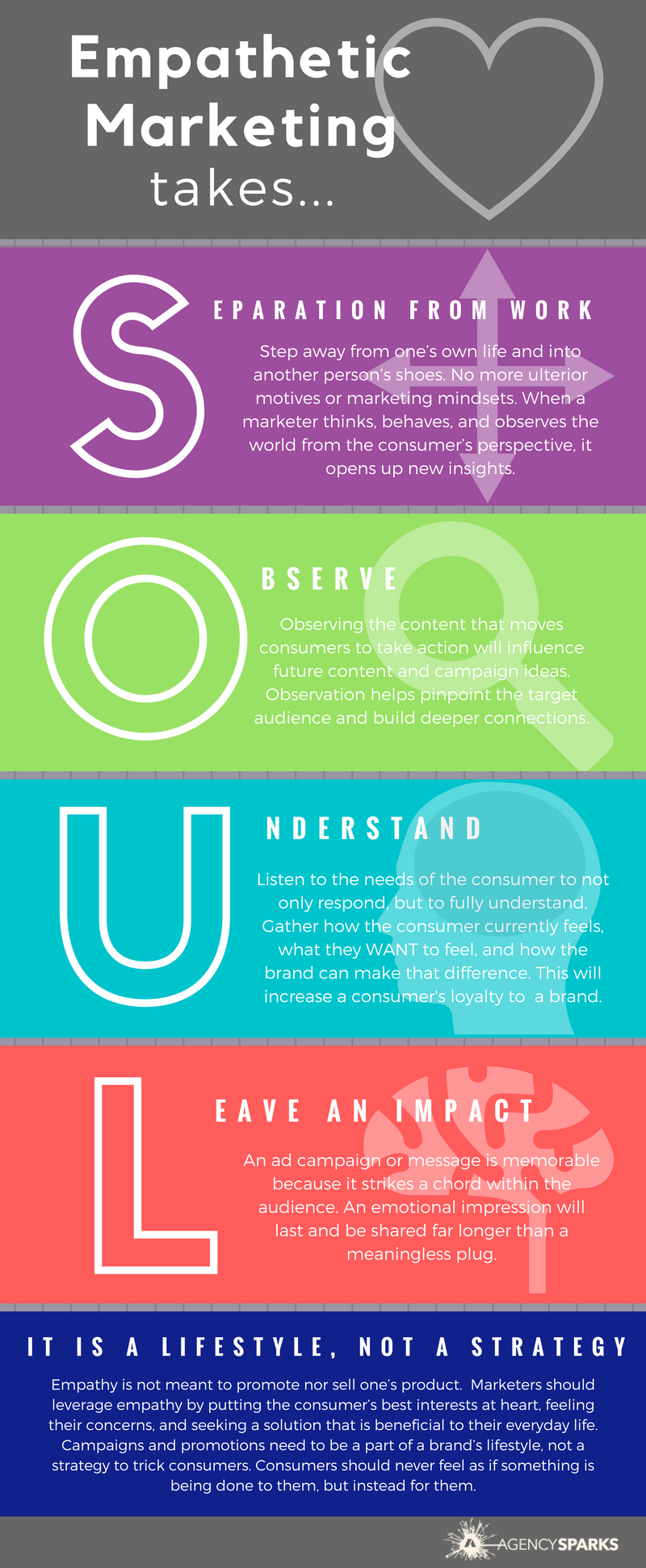Being An Empathetic Marketer Takes S.O.U.L.
In addition to having opposable thumbs, humans ability to be empathetic is a great asset. The mere fact two people can sit down, share, and relate to the feelings and struggles of one another is incredible, not to mention powerful. With that power comes responsibility.
Too often brands take advantage of customers when attempting to be empathetic. The truth is, empathy is not meant to promote nor sell one’s product.
Empathy is an emotional connection, that is, as Dr. Brené Brown states, “feeling with people.” Marketers should leverage empathy by putting the consumer’s best interests at heart, feeling their concerns, and seeking a solution that is beneficial to their everyday life.
Thirst for instant results from social media and data can cloud the judgement of marketers. Campaigns and promotions need to be a part of a brand’s lifestyle, not a strategy to trick consumers. Consumers should never feel as if something is being done to them, but instead for them.
Believe in good. By helping and understanding others and trying to lift them up, the man in the commercial’s life is better. This brand does not push a product but instead promotes being empathetic. As an insurance company, the brand needs to be there for it’s clients so, in return, the commercial promotes being there for one another. It is a lifestyle, not a strategy. If businesses help consumers and those around them, they will prosper partially because the world is better for it.
What does it mean to have S.O.U.L?
SEPARATION FROM WORK
Thinking like a marketer and thinking like a consumer are completely different mindsets. With instant data and social media, the emotional aspect of marketing can be forgotten. Goals become more about the reach and impression percentage rather than the emotional reach and the impactful impression. When there is an angle behind the advertising, a consumer can sense it and lose trust. With an empathetic approach, every action is for the benefit of the consumer - which in turn benefits the brand.
The best solutions come from stepping away from one’s own life and into another person’s shoes. No more ulterior motives or marketing mindsets! When a marketer thinks, behaves, and observes the world from the consumer’s perspective, it opens up new insights.
OBSERVE
By taking in how people within a target market behave, respond, and act on a day to day basis, it is easier to cater to their needs. Empathetic marketing is bringing a product or service into a consumer’s life because they NEED it or it will advance their lifestyle in some way.
How do marketers know what consumers need? By interacting with them and noticing behaviors. Observing the content that moves consumers to take action will influence future content creation and campaign ideas.
Observation helps pinpoint the target audience. Once a brand knows exactly who is interested, they can develop personas which are in depth outlines of the influences, behaviors, habits, emotions, and goals of the target audience. Personas aid the brand in developing a better, more impactful message that resonates with the clientele.
Ultimately, narrowing in on the customers who are interested in the brand and how they think will build deeper emotional connections.
UNDERSTAND
Observation is a key factor in understanding the perspective of the consumer, but having a conversation to hear them out is taking it a step further. Listen to the needs of the consumer. Listen to not only respond, but to fully understand. Gather how the consumer currently feels, what they WANT to feel, and how the brand can make that difference.
Brand loyalty increases when a consumer has an emotional attachment to the brand or it’s message. When a brand takes the time to discover the issues that are important to consumers, their struggles, their sentiments, then brands can produce solutions to relieve those issues, which helps form deeper bonds.
LEAVE AN IMPACT
An ad, campaign, or message is memorable because it strikes a chord within the audience. An emotional impression will last and be shared far longer than a meaningless plug.
S.O.U.L. in Action
Food is not the first thing that comes to mind when attempting to be empathetic. This grocery store does a phenomenal job advertising what food can do for people. Families love one another and typically spend time together on the holidays.
EDEKA stepped away from advertising their product and stepped into the consumer’s shoes. They observed how families behave towards one another and understood that sometimes the holidays call for busy times. The commercial made an emotional impact by bringing everyone happily together with food. The product was not the focal point. The campaign was successful because it focused on the consumer’s feelings and happiness.

